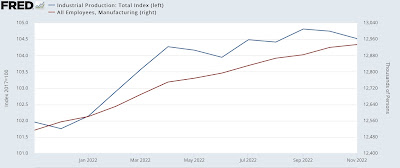- by New Deal democrat
- 223,000 jobs added. Private sector jobs increased 220,000. Government jobs increased by 3,000. The three month moving average of growth declined further to 247,000.
- The alternate, and more volatile measure in the household report had its best month in quite awhile, increasing by 717,000 jobs. The above household number factors into the unemployment and underemployment rates below.
- U3 unemployment rate declined -0.2% to 3.5%.
- U6 underemployment rate also fell -0.2% to 6.5%.
- the average manufacturing workweek, one of the 10 components of the Index of Leading Indicators, declined -0.3 hours to 40.6, and is down -1.0 hours from its February peak last year of 41.6 hours. This is recessionary.
- Manufacturing jobs increased 8,000, and are at a level higher than before the pandemic.
- Construction jobs increased 28,000, also at a level higher than before the pandemic.
- Residential construction jobs, which are even more leading, increased by 3,100.
- Temporary jobs, which until several months ago had been rising sharply, declined again, by 35,000.
- the number of people unemployed for 5 weeks or less declined by 11,000 to 2,233,000, about 100,000 above its pre-pandemic level.
- Average Hourly Earnings for Production and Nonsupervisory Personnel, which was recorded at $28.10 in November, was revised downward by $-.09, and increased $.06 from that to $28.07, a 0.2% gain m/m, and up 5.0% YoY, vs. its 6.7% peak at the beginning of 2022.
- the index of aggregate hours worked for non-managerial workers declined for the second month in a row, by -0.2% which is still above its level just before the pandemic.
- the index of aggregate payrolls for non-managerial workers was unchanged, and is up 7.4% YoY. This metric has been decelerating nominally almost consistently for the past 16 months. Compared with inflation through November, it is up only 0.2% YoY (recessions typically start when it crosses zero).
- Leisure and hospitality jobs, which were the most hard-hit during the pandemic, rose 67,000, but are still about -6% below their pre-pandemic peak.
- Within the leisure and hospitality sector, food and drink establishments added 26,300 jobs, but are still about -4% below their pre-pandemic peak.
- Professional and business employment declined -6,000, the second poor reading in a row after last month’s measly increased of 1,000.
- Full time jobs decreased -1,000 in the household report.
- Part time jobs increased 689,,000 in the household report.
- The number of job holders who were part time for economic reasons rose 190,000.
- The Labor Force Participation Rate increased 0.2% to 62.3%, vs. 63.4% in February 2020.
- Those not in the labor force at all, but who want a job now, declined -352,000 to 5.176 million, compared with 4.996 million in February 2020.
- October was revised downward by -21,000, and November was also revised downward by -7,000, for a net decrease of -28,000 jobs compared with previous reports. This is at least the second such downward revisions in a row.









